Five Nests To Find This Year
April 13, 2018Story and art by Raisa Kochmaruk, Cornell Class of ‘21
Earlier this year, we issued a friendly challenge to get you to think outside of the [nest] box when it comes to finding nests. There are common birds nesting all around us that NestWatch wants to hear about, and it only takes a little bit of know-how to find them. To help you join the challenge, we’ve picked five beloved backyard birds that frequently nest near people. Feel free to download and keep these original illustrations as a reminder to keep your eyes trained for a nest this year. If you find a nest, we would love for you to report your observations to us.
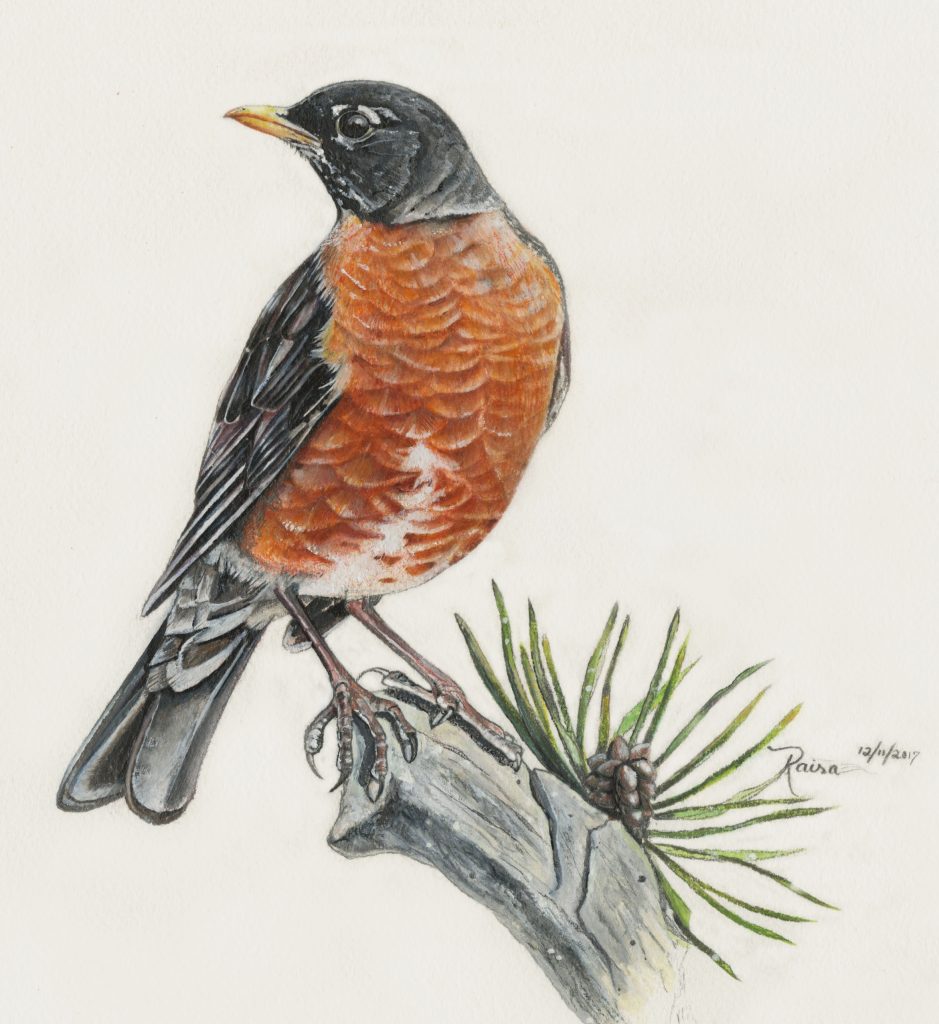
American Robin
The Mud Molder
You’ll spot this medium-sized bowl-shaped nest about 5-25 feet off the ground in a tree, shrub, or on a building. The construction is distinctive because of the thick mud used to hold it together, which its builder painstakingly transports by the beakful during building season. Between the layers of mud which hold the nest together, fine, dry grasses poke out in all directions. The bird who created this nest is non-migratory, and can be seen all year throughout the United States, although they appear in greater numbers during the summer in Canada and are seen more commonly in the Southern states and Northern Mexico during colder months. These poised and purposeful workers will use their wrists to press the mud into the grasses, building their nests from the inside out. Learn to identify the nest of an American Robin here!
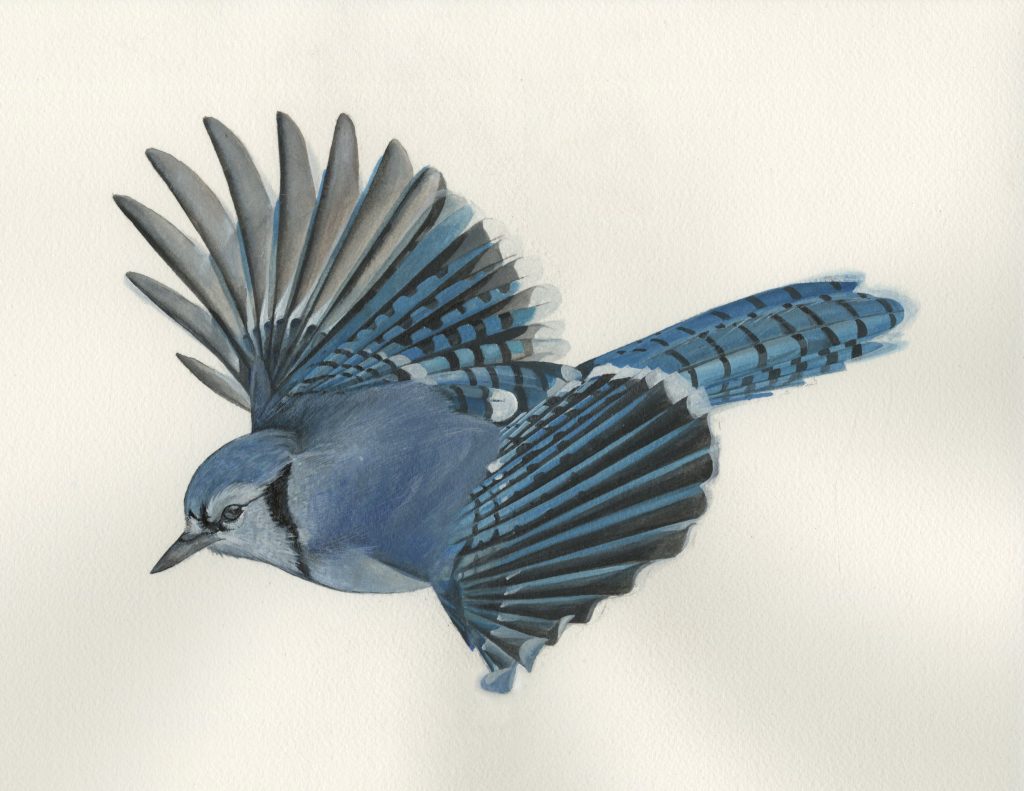
Blue Jay
The Bulky Basketmaker
This next nester builds a large, messy cup of sticks, grasses, and sometimes even mud, which is then lined with small roots. Nests can be found 10 to 25 feet above the ground, in both coniferous and deciduous trees, placed between major forked and outer branches. Both the male and female collect materials, but the female does most of the building. Live twigs are broken off to build such a nest and the pair will often fly long distances to bring back the roots they’ve dug from shallow ditches. Although these bright residents of the Eastern United States are known for being noisy and bold, they have intricate social systems and family bonds that stay strong throughout the year. Form your search image of a bulky Blue Jay nest now.
Don’t have Blue Jays in your area? Try searching for a California Scrub-Jay or Woodhouse’s Scrub-Jay nest!
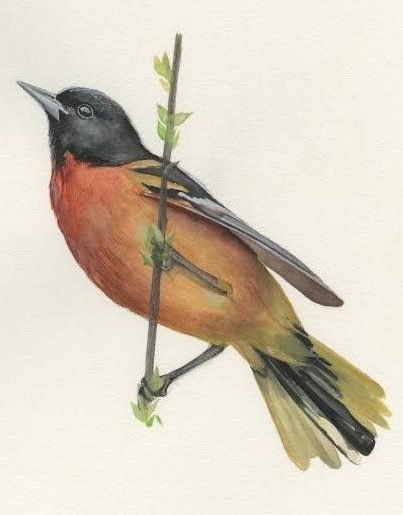
Male Baltimore Oriole
The Resourceful Weaver
Thin woven fibers comprise this distinctive hanging nest, which has a large bottom chamber to house the eggs. The female builds this pouch-like nest by first hanging long fibers over a branch, tangling them with her long beak, and then adding material to strengthen the nest before lining it with softer natural fibers and downy feathers. Some of the items she may collect include fishing line, twine, horsehair, grapevine bark, and cellophane. Elms are the favored nesting trees of these birds, and the nest either will hang completely from a forked branch or be placed against the trunk. Creating this nest takes weeks, and although the males may help gather building materials, females are the sole architects. These migratory songbirds spend their winters in central and northern South America, and keep to the Eastern United States and South-Central Canada during the summer. Look for the woven wonder of the Baltimore Oriole nest in a relatively open spot.
No Baltimore Orioles where you live? Bullock’s Orioles also weave a similar hanging nest!
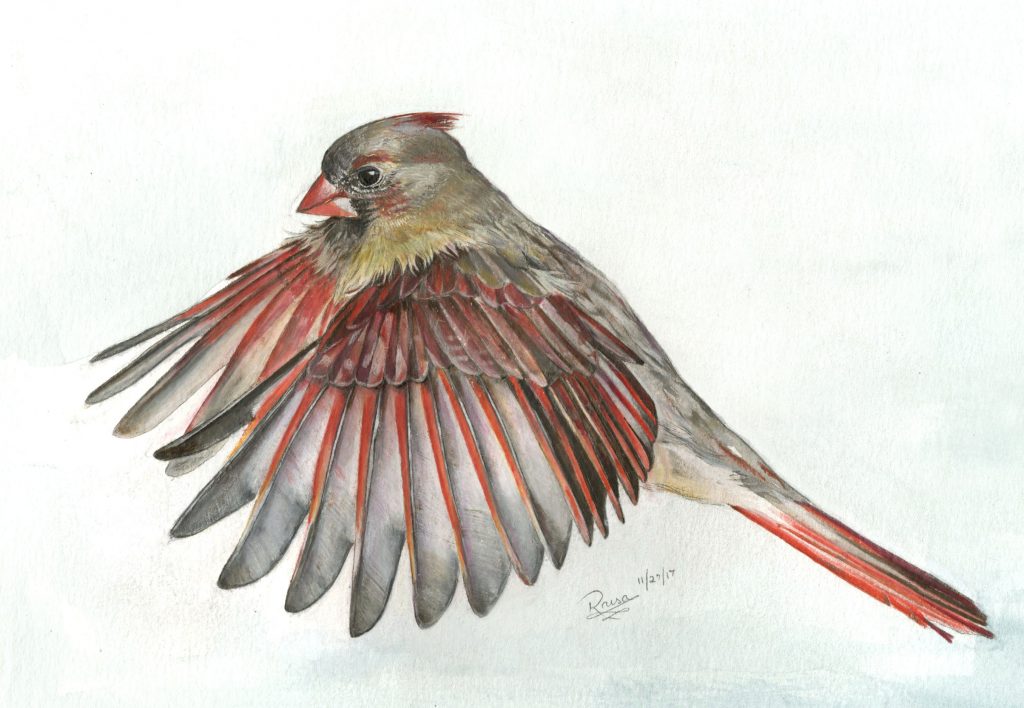
Female Northern Cardinal
The Twig Tamer
The female of this species is the primary architect—a common trend among nest-building birds—although the male does supply her with materials for building and with food while she’s nesting. She’s resourceful, too, and uses her thick beak to crush twigs until they are bendable, pressing them into a nest shape with her body. Several ingredients comprise her nest: coarse twigs, a leafy barrier, grapevine bark, grasses, stems, small roots, and pine needles. Mated pairs of this species have an interesting technique for deciding where to build their nest: the female will visit potential sites, with the male following close behind, all the while calling to each other with special songs until they decide on a spot. Their nests will usually be found wedged into forked branches of saplings and vines, such as dogwood, honeysuckle, rose bushes, hemlock, and blackberry brambles. Look carefully into a thick shrub nearby to see if you can find the lovely Northern Cardinal nest.
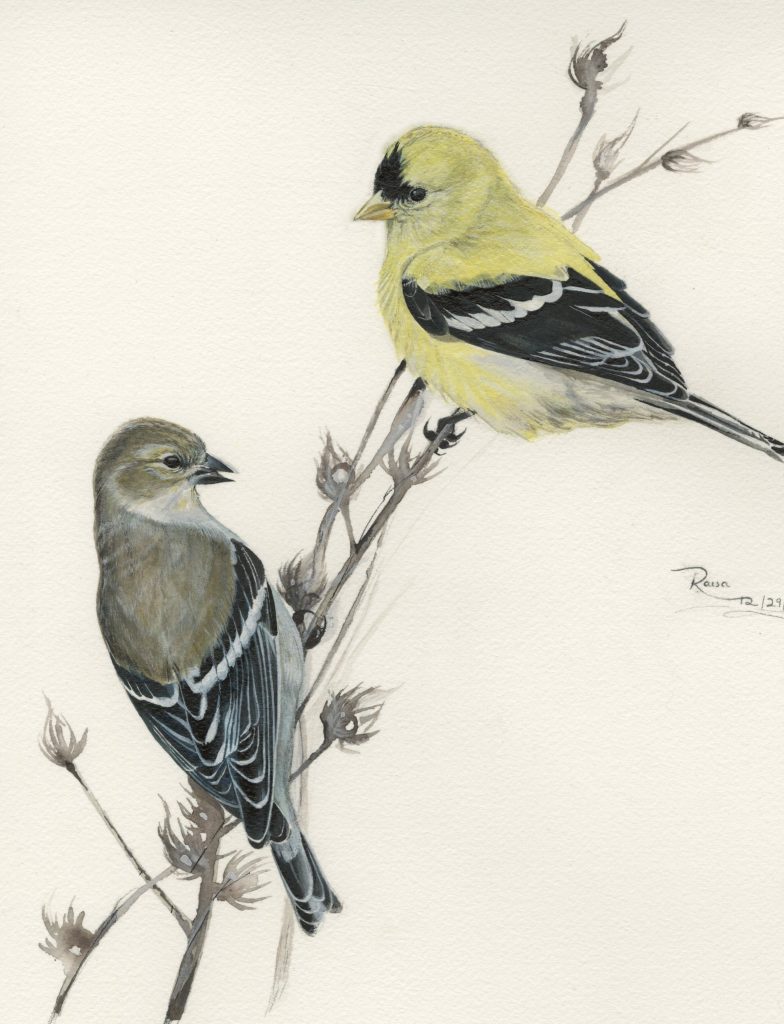
Male and Female American Goldfinch
The Fluff Stuffer
This small, teacup-shaped nest can be spotted three to ten feet off the ground in a small tree or shrub, typically in open woodlands or overgrown fields. The nest is composed of milkweed, thistle, and other fluffy or stringy plants that grow in fields, floodplains, roadsides, yards, and orchards. Its maker can be seen year-round in the Eastern and Midwestern United States, and also in the Northwest, except for California and western Oregon. These small, strictly vegetarian birds wait for their preferred nesting materials to grow and seed before they lay their clutch, as the seeds provide nourishment for newly hatched young. These swift little birds build their nests in three steps: first, twigs are connected by spider silk, then a tighter cup of small roots and debris is woven inside, and finally, soft, downy material is used to cushion the very center of the nest. Can you spot the late-season nest of the American Goldfinch in July and August?
Live in the West? Try searching for Lesser Goldfinch nests instead.
You can learn more about bird nests across the continent on our Common Nesting Birds tool.

21 comments on “Five Nests To Find This Year”
We had an American robin nest in the Dogwood tree last year and a hawk swept in and ate the the hatchlings.
I hope they build elsewhere this year.
I have an American Robin nest above my door! They hatched three times.
Oh, no! I hope they find a safer place, too.
The Baltimore orioles in my yard make a nest in my weeping willow tree branches hanging over the river. They return to that spot every year.
Right now we have an American robin building her nest in my large Christmas cactus hanging on our front porch. Over the years we have had cardinals, mourning doves and another pair of robins build their nests in this same plant. The nicest thing about this plant is it is big and full and is a safe place to raise baby birds. We can observe them from the upstairs bedroom window without bothering them. They are so much fun to watch!
We have American robins nest in a large Leland Cyprus tree right next door, but always at least 20′ AGL so impractical to monitor. Do see the parents flying in regularly to feed the young though.
i hung a tiny birdhouse on a tree like 4ft high. theres the tiniest little bird in there sitting on a tiny nest…..i can’t get a good picture because that would mean i have to use the flash and i don’t want to frighten her! She initially started building her nest in the birdhouse while is was on the ground…what could this bird be?
Hi MarLo,
Have you seen the bird outside of the nest? If so, please feel free to email us at nestwatch@cornell.edu with a more detailed description of the bird and we can help you with identification. Not every bird builds a nest in a bird house, though it is odd that it started building the nest while the house was on the ground.
Thanks!
Holly Faulkner, Project Assistant.
Hmmm?????
Check out Merlin
I found a new-to-me species nesting attempt this year, a European Starling, but it’s nest was about 2 1/2 stories up in a tree cavity. I saw it in the process of clearing out the cavity and much other activity at the entrance hole, but did not have a clue as to how to monitor it since viewing the nest contents was out of the question. It would be impossible to say how large the clutch was, how many hatched, whether any died in the nest, etc… Can anyone give some tips on how they report a nest of this kind? Thanks.
P.S. By the way, thank you again Raisa and Cornell for the downloads of the beautiful illustrations. These are going on my desktop! 🙂
Hi Paula, that’s a tough one. It sounds like your nest is beyond the reach of a stepladder, pole-mounted camera (or selfie stick), or even a “snake cam” / borescope. The best way to monitor that nest would be with binoculars, from the ground. And you’re welcome for the illustrations!
I recently noticed yesterday, that the cowbirds were observing the robins nest in our Pinetree. The male cowbird went and agitated the female and male robin getting them away from the nest. Then, when they were away from the nest chasing the male cowbird off, the female cowbird flew up to the robins nest. I suppose she laid an egg. I have never observed this before. What stealthy moves the cowbirds have to claim a new nest to lay an egg in. A nest that they didn’t build. So, I suppose that we will have a new little cowbird in the field following behind our grazing horses in a couple of weeks. I knew that they followed the Buffalo and never had the time to build nest as to keep up with the herds. Very interesting and crazy how that they have adapted to this sort of life. God’s creation is amazing! ?????
Every spring I watch little song sparrow feeding gigantic cowbird chicks.
I tried to find the nest to pick out the cowbird’s eggs but no luck. It’s a eye sore to watch.
Hi Sue, It may be a good idea to check into the laws in your state. Brown-headed Cowbirds are native species and protected under the Migratory Bird Treaty Act, so removing eggs from the nest is illegal, but some states have special programs where it’s OK to remove them only under certain circumstances.
Hi Sue, I recently found a fledgling Cowbird, so I read up on the internet about how adults are always following herds as you mentioned. It also said mom has no time to look after babies so they find a surrogate family as you observed. Interesting to read someone actually observing how this is done ( :
I found a American Robin nest in a spruce tree, That was a wile a go, But sadly one egg did not hatch, But there was two fledgling.
Last year I saw a pendulous nest in my Mayten tree. Not having seen any orioles around Modesto since I was a child, I searched the Internet for a different bird that would make such a nest. I had noticed tiny gray birds hovering around the nest if I got too close. Idiom found the name of these birds—bushtits. They do make this type of nest.
Luella, you’re right! Bushtits do make a long, sock-like nest. I used to see them when I lived in California. Well observed!
I have a pair of Eastern Phoebe’s that nest under my front porch each year. After watching them the first year, I put up a shelf for them to build their nest on. They have already built their nest and laying eggs.
We have a pair of Bewicks Wrens that nest in our yard. They are quite conspicuous and build several nests in diferent locations until settling on one. Last year it was under an upside down pot up on a foot high wire pot stand under a young fan palm! I wish I could post the pictures here!